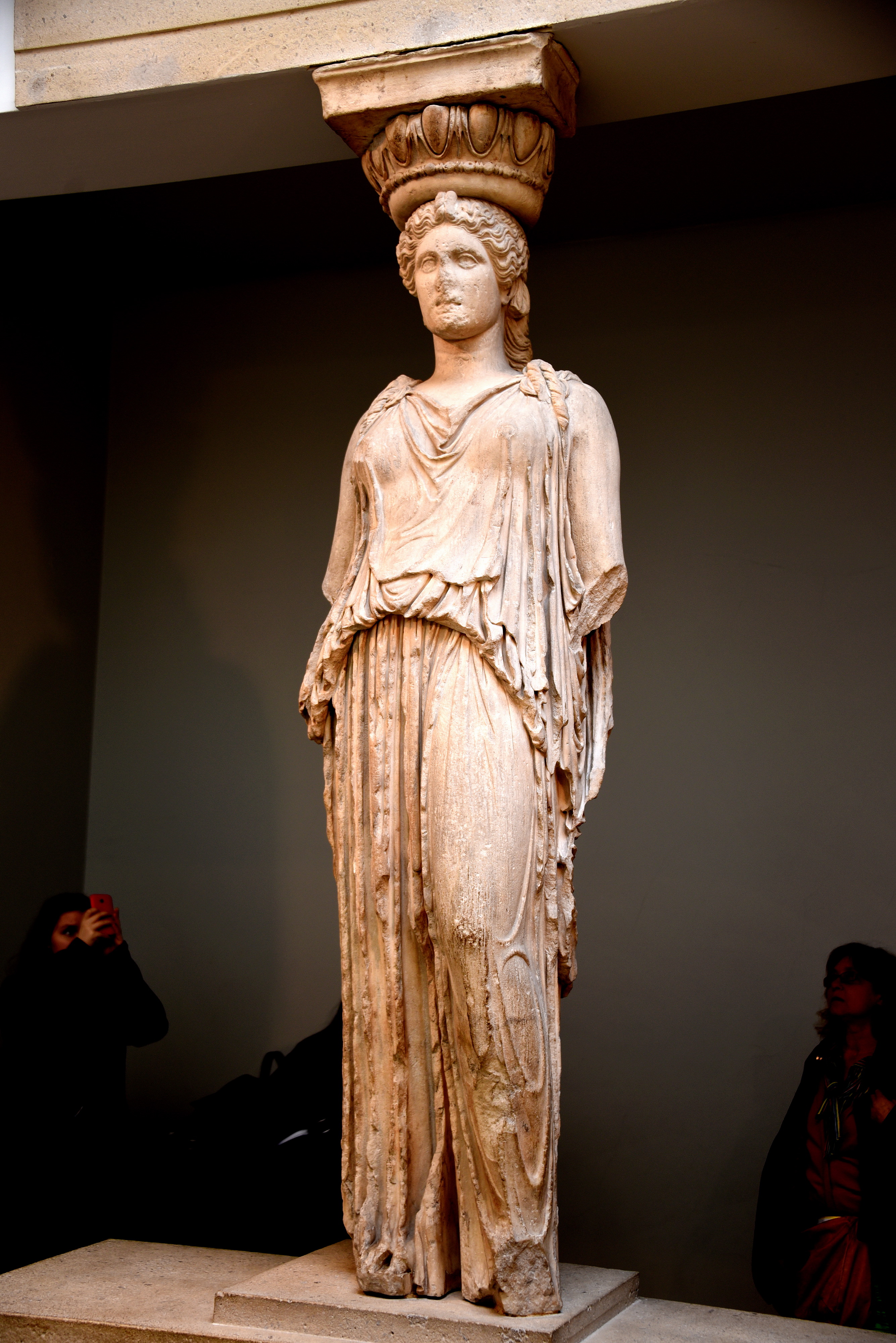
the British museum caryatid British museum, Greek statue, Statue
Caryatids, 421-405 BCE, Acropolis Museum, Athens, Greece, photographed by Why Athens. Each woman wears the peplos and himation and had a bent leg, but also they have very different features and details, especially in the face and hair. They are not just copies of the same figure, there is individuality to each of them.

Caryatid from the Erechtheum at the British Museum in London Editorial Stock Image Image of
The missing Caryatid is installed at the British Museum in London, which acquired it nearly two centuries ago after Lord Elgin, the British ambassador to the Ottoman Empire, had it sawed.

Caryatid from the Erechtheum (Illustration) World History Encyclopedia
Caryatid (South Porch) and Ionic Column (North Porch), Erechtheion on the Acropolis, Athens, marble, 421-407 B.C.E., Classical Period (British Museum, London). Mnesicles may have been the architect. The caryatid The Erechtheion is perhaps the most complex building on the Acropolis.

British Museum British museum, Victorian dress, Museum
A caryatid ( / ˌkɛəriˈætɪd / or / ˌkæriˈætɪd / KAIR-ee-AT-id or KARR-ee-AT-id; [1] Ancient Greek: Καρυᾶτις, pl. Καρυάτιδες) [2] is a sculpted female figure serving as an architectural support taking the place of a column or a pillar supporting an entablature on her head.

caryatid British Museum
The Promenade and Marina front at A Coruna. One of A Coruna's most visible features is its relatively new sea facing promenade and the interesting buildings and sights that line it. The main city is set back slightly from this walkway and there is also a road that separates the path from the town. The promenade was started in the late nineteen.

CaryatidErechtheumBritish_Museum Elgin marbles, British museum, Greek artwork
05 August 2020 Caryatid is a sculpted female figure serving as architectural support in the place of a column or a pillar. Its purpose in architecture is mainly decorative. The most famous Caryatids are the ones of Erechtheion on Acropolis Hill, Athens. Let's find out more about these fascinating "Maidens"!

caryatid British Museum
The British Museum's caryatid is better preserved than her sisters, which have now severely weathered. They have recently been removed to the Acropolis Museum and replaced by casts. Details. Title: Caryatid from the Erechtheion; Date Created:-415/-415; Physical Dimensions: Height: 2.28m (about)

British Museum Image gallery caryatid
canephore caryatid, in classical architecture, draped female figure used instead of a column as a support.

British Museum, London, UK. The Erectheum Caryatid, one of the Elgin Marbles brought to London
The Erechtheion is an ancient Greek temple on the Acropolis of Athens in Greece. It was dedicated to both Athena and Poseidon. The Erectheum was associated with some of the most ancient and holy relics of the Athenians. What do the caryatids represent? A caryatid is a sculpted female figure serving as architectural support elements.

caryatid British Museum
caryatid. Object Type caryatid. Museum number 1853,0110.7. Description. CVA British Museum 7 / Corpus Vasorum Antiquorum: Great Britain 10, British Museum 7 (IVBa pl. 12, 8) Location Not on display. Acquisition name Purchased from: Harry Osborn Cureton Purchased through: Sotheby's.

Erechtheum Caryatid British museum, Ancient times, Ancient art
Caryatid is the name given to an architectural column which takes the form of a standing female figure. The first examples come from ancient Greek architecture and indeed, the most celebrated examples are found in the south porch of the Erechtheion on the acropolis of Athens, the originals of which are now in the city's Acropolis Museum.. Naming & Origins.

British Museum caryatid
Detail A Greek Caryatid from Attica In 1801 the Cambridge professor E. D. Clarke visited the village of Eleusis near Athens, once the site of an important sanctuary dedicated to Demeter, the Greek goddess of corn and fertility. He observed this statue 'in the midst of a heap of dung, buried as high as the neck', and went on to explain that

London, England JUNE 16, 2018 Greek caryatid marble statue at the British Museum Stock Photo
November 28, 2023 Replicas of the original Caryatids holding up the Erechtheion in Athens atop the Acropolis. Five original Caryatids are now in the Acropolis Museum, but the sixth Caryatid was carted away by Lord Elgin back in 1802 when he made off with the rest of his spoils from the Acropolis, including the Elgin Marbles.

Caryatid from the Erechtheum at the British Museum in London Editorial Stock Image Image of
Caryatid from the Erechtheum (Illustration) - World History Encyclopedia Caryatid from the Erechtheum Illustration by Osama Shukir Muhammed Amin published on 12 May 2016 Download Full Size Image This pentelic marble caryatid came from the Erechtheion, Athens, Greece. She was 1 of 6 caryatids that held up the roof of the Erechtheion. Circa 415 BCE.

British Museum 2012 The Townley Caryatid 2 The Townley C… Flickr
The first of these is one of A Coruna's oldest buildings, the Church of Santiago (Iglesia de Santiago). Originally built in the 12th century, it was modified in the 14th and 15th centuries and has huge historic significance on account of a 13th century statue of Saint James which it houses. Some of the more prominent aspects of the churches.

caryatid British Museum
The missing Caryatid, removed from Greece in the early 19th century by Lord Elgin, found a new home at the British Museum in London. While her sisters stand in solidarity on their ancient pedestal, she resides thousands of miles away, separated by time, geography, and a longing for reunion.